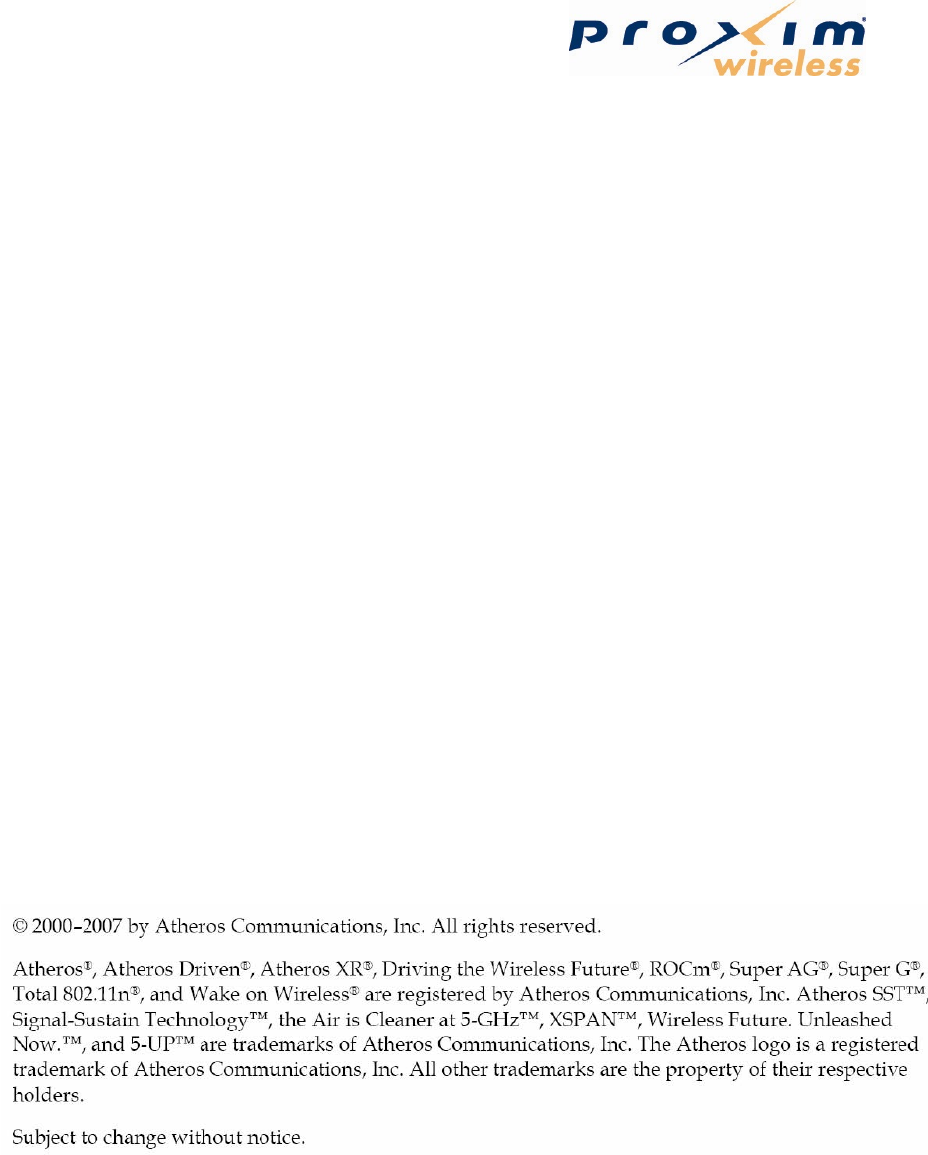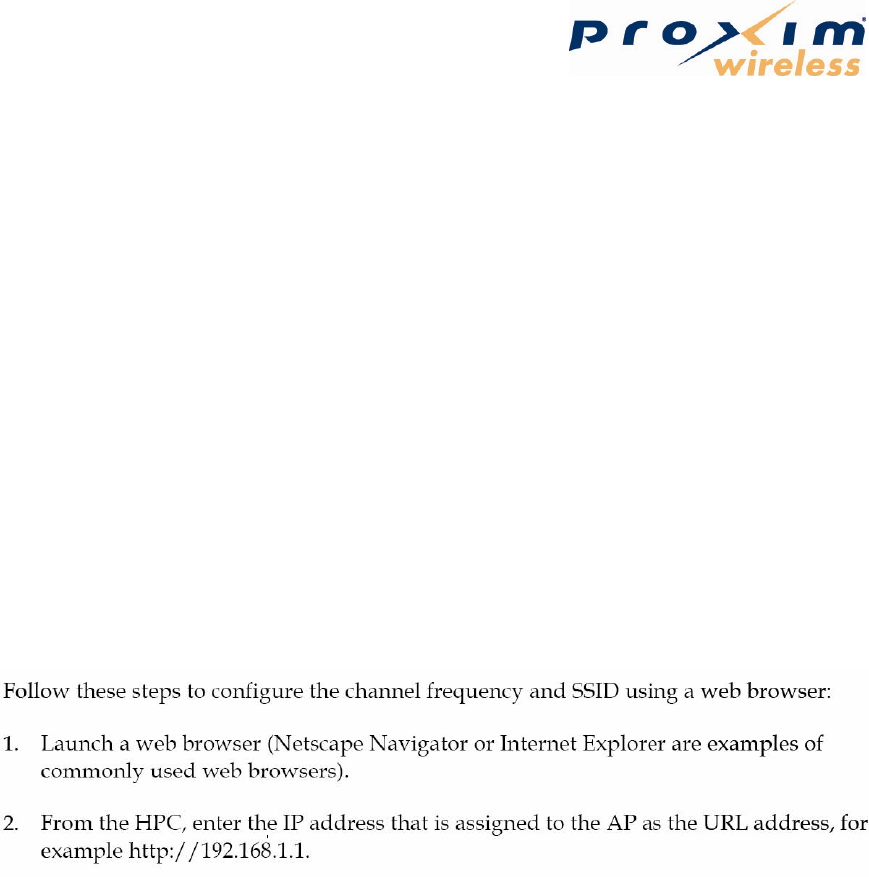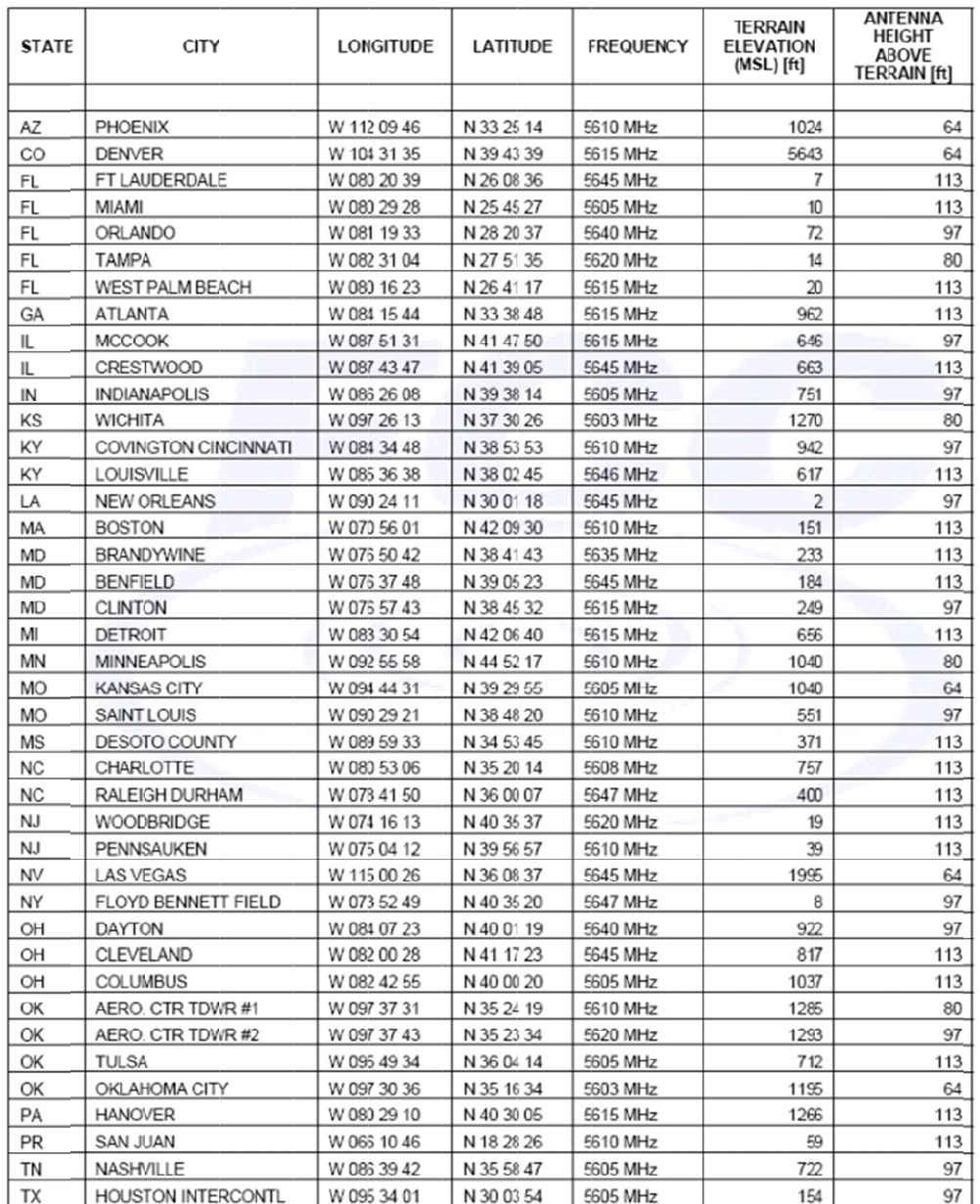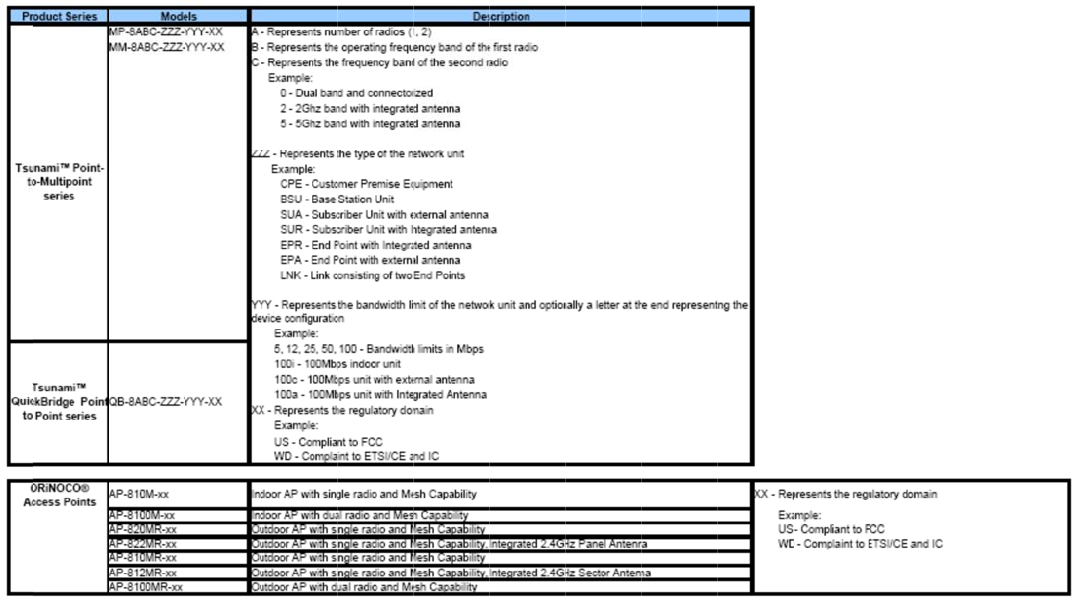Proxim Wireless PROXMB92 miniPCI High Power MIMO IEEE 802.11 a/b/g/n RFModule User Manual MB82 HP 2011 08 30
Proxim Wireless Corporation miniPCI High Power MIMO IEEE 802.11 a/b/g/n RFModule MB82 HP 2011 08 30
Contents
- 1. Users Manual
- 2. user manual
- 3. Module user manual
- 4. System user manual
Module user manual

mini PCI High Power MIMO IEEE 802.11 a/b/g/n
RF Module User’s Guide

NOTICE:
The information in this document has been carefully reviewed
and is believed to be accurate. Nonetheless, this document is subject to change without notice, and
Proxim Wireless Corporation (Proxim) assumes no responsibility for any inaccuracies that may be
contained in this document and makes no commitment to update or to keep current the contained
information, or to notify a person or organization of any updates. Proxim reserves the right to attempt
to supply the best product possible. Proxim dos not represent the products described herein are free
from patent infringement or from any other third party right.
Subject to change without notice.
PROXIM MAKES NO WARRANTIES OF ANY KIND WITH REGARD TO THE CONTENT
OF THIS DOCUMENT, IN NO EVENT SHALL PROXIM BE LIABLE FOR DIRECT,
INDIRECT, SPECIAL, INCIDENTAL SPECULATORY OR CONCEQUENTIAL DAMAGES
ARISING FROM THE USE OR INABILITY TO USE THIS PRODUCT OR
DOCUMENTATION, EVEN IF ADVISED OF THE POSIBILITY OF SUCH DAMAGES. IN
PARTICULAR PROXIM SHALL NOT HAVE LIABILITY FOR ANY HARDWARE,
SOFTWARE, OR DATA TRANSMITTED OR OTHERVWISE USED WITH THE PRODUCT,
INCLUDING THE COST OF REPARING, REPLACING, INTERGATING, INSTALLING OR
RECOVERING SUCH HARDWARE, SOFTWARE OR DATA.
This document use information provided by Atheros Communications Inc. (Atheros), Atheros radio
and chipsets user manuals, technical specifications, and Atheros regulatory manual.

INTRODUCTION
The Proxim PROXMB82 miniPCI module implements an IEEE
802.11a/b/g/n wireless LAN (WLAN) with DFS Master function. MIMO operation is implemented
using three transmit and three receive chains per the 802.11n standard.
The device will be marketed under brand name: PROXMB and model: PROXMB82.
This module may be installed in PC and host processor systems using approved external antennas.
The module may be configured for 2.4 GHz or 5 GHz operation USING THE Web Server function
provided by Atheros Communications Inc. Please, refer to Atheros’ driver User Manual instructions
for details.

CONFIGURATION
This section provide procedures for connecting and configuring
the AP. Configuration can be performed either from a web browser accessing the build-in web server,
or by entering commands using the command line interface (CLI). For detailed information on using
the server refer to “AP Web Server and for using CLI, refer to detailed operational guide provided by
Atheros for the chipset.
AP Initial Configuration
Configure the AP for its Service Set Identifier (SSID) unique to the application. This configuration
can be done either through a web browser with access to the build-in AP web server, or by
commands using the command line interface (CLI).
WEB Browser
3. Select the Access Point Web Server hotlink.
4. A dialog box appears requesting login authorization. When prompted, enter the following
information to log in:
Login: Admin (case-sensitive) Password: 5up
5. Click OK to complete the login process. The 5 GHz Statistics window will appear.
6. Select the Configuration hotlink from the navigation menu. The system Configuration window will
appear.
7. Enter the SSID (name or address) for the AP in the SSID field. The SSID must be 132 characters in
length.

To configure a single SSID to have more then one AP in a
single SSID, specify a unique System Name for each AP within
that single SSID. Note that range of available channels will be automatically determined by factory
settings.
Note that the radio channel is specified using the IEEE 802.11 a standard. For example, channel 48 is
the equivalent of 5.240 GHz. The channel number is derived as:
Channel Frequency (in MHz) – 5000 MHz
Channel Number = 5MHz
1 Click Update to commit the changes.
2 After all configuration changes are complete, reboot the AP to enable them. To reboot AP,
click on the REBOOT AP button that appears.
For detailed information on using the server refer to “AP Web Server” and for using CLI refer to “AP
Command-Line Interface” provided in Appendixes A and B of Atheros MPCI Module User’s Guide.

FCC Requirements for Operation in the United
States
This device is restricted to indoor use only due to its operation in 5150 to 5250 MHz and 5470 to
5725 MHz frequency ranges in accordance with latest FCC regulations.
Host systems using Porxim Firmware with this 802.11 a/b/g/n 3x3 MIMO nimiPCI module to be
sold in the United States do not have country code settings and are factory configured to only
operate on the channels allowed by the FCC. Master devices with a US SKU that contain the 802.11
a/b/g/n Radio module are limited to the following operating channels:
? 1 -11 (2412 to 2462 MHz) in the 2.4 GHz band
? 36 – 64 (5180 to 5320 MHz) in the 5150 to 5350 MHz band
? 100 – 116 (5500 to 5580 MHz) and 132 – 140 (5660 to 5700 MHz) in the 5470 to 5725 MHz
band
? 149 – 165 (5745 to 5825 MHz) in the 5725 to 5825 MHz band
High power radars may use the 5250 to 5350 MHz and 5470 to 5725 MHz frequency ranges in your
area. Such radar stations can cause interference and damage to this device. This radio module
implements a radar detection function which may cause interruption of normal operation when radar
signal is detected.
This equipment has been tested and found to comply with the limits for a Class B digital device,
pursuant to Part 15 of the FCC Rules.
RF Exposure
To ensure compliance with FCC RF exposure requirements, the antennas used for this device
must be installed to provide a separation distance of at least 20 cm from all persons.
Outdoor operations in the 5150~5250MHz, 5600~5650MHz band is prohibited.
This device has no Ad-hoc capability for 5250~5350MHz and 5470~5725MHz.
In order to meet new FCC, NTIA, FAA and industry restrictions to resolve interference to
Terminal Doppler Weather Radar (TDWR) systems used at airports, any outdoor device installed
within 35 km of a TDWR location must be separated by at least 30 MHz (center-to-center) from
TDWR operating frequency (as shown in the table below). Channels 120-132 and 5600-5650
MHz band are disabled on outdoor products.
We recommend that all operators and installers register the location information of the UNII
devices operating outdoors in the 5470 – 5725 MHz band within 35 km of any TDWR location at
the WISPA sponsored database (see http://www.spectrumbridge.com/udia/home.aspx). This
database may be used by government agencies in order to expedite resolution of any interference
to TDWRs.
Procedures on how to register the devices in the industry-sponsored database with the appropriate
information regarding the location and operation of the device and installer information can be
found on the database.

TDWR Locati
o
o
n Infor
m
m
ation:

FCC Statement:
Federal Communication Commission Interference Statement
This equipment has been tested and found to comply with the limits for a Class B digital device,
pursuant to Part 15 of the FCC Rules. These limits are designed to provide reasonable protection
against harmful interference in a residential installation. This equipment generates, uses and can
radiate radio frequency energy and, if not installed and used in accordance with the instructions, may
cause harmful interference to radio communications. However, there is no guarantee that interference
will not occur in a particular installation. If this equipment does cause harmful interference to radio or
television reception, which can be determined by turning the equipment off and on, the user is
encouraged to try to correct the interference by one of the following measures:
● Reorient or relocate the receiving antenna.
● Increase the separation between the equipment and receiver.
● Connect the equipment into an outlet on a circuit different from that to which the receiver is
connected.
● Consult the dealer or an experienced radio/TV technician for help.
FCC Caution: Any changes or modifications not expressly approved by the party responsible for
compliance could void the user’s authority to operate this equipment.
This device complies with Part 15 of the FCC Rules. Operation is subject to the following two
conditions: (1) This device may not cause harmful interference, and (2) this device must accept any
interference received, including interference that may cause undesired operation.
For product available in the USA/Canada market, only channel 1~11 can be operated. Selection of
other channels is not possible.
This device and its antenna(s) must not be co-located or operation in conjunction with any other
antenna or transmitter.
This device is going to be operated in 5.15~5.25GHz frequency range, it is restricted in indoor
environment only.
FCC NOTICE: To comply with FCC part 15 rules in the United States, the system must
be professionally installed to ensure compliance with the Part 15 certification. It is the responsibility
of the operator and professional installer to ensure that only certified systems are deployed in the
United States. The use of the system in any other combination (such as co-located antennas
transmitting the same information) is expressly forbidden.
IMPORTANT NOTE:
FCC Radiation Exposure Statement:
This equipment complies with FCC radiation exposure limits set forth for an uncontrolled
environment. This equipment should be installed and operated with minimum distance 20cm between
the radiator & your body.
IMPORTANT NOTE:
This module is intended for OEM integrator only and limited to host with brand: Tsunami/ORiNOCO
and model list. The OEM integrator is still responsible for the FCC compliance requirement of the end
product, which integrates this module.
20cm minimum distance has to be able to be maintained between the antenna and the users for the
host this module is integrated into. Under such configuration, the FCC radiation exposure limits set
forth for a population/uncontrolled environment can be satisfied.
Any changes or modifications not expressly approved by the manufacturer could void the user's
authority to operate this equipment.
USERS MANUAL OF THE END PRODUCT:
In the user’s manual of the end product, the end user has to be informed to keep at least 20cm
separation with the antenna while this end product is installed and operated. The end user has to be
informed that the FCC radio-frequency exposure guidelines for an uncontrolled environment can be
satisfied. The end user has to also be informed that any changes or modifications not expressly
approved by the manufacturer could void the user's authority to operate this equipment.
LABEL OF THE END PRODUCT:
The final end product must be labeled in a visible area with the following " Contains TX FCC ID:
HZB-PROXMB92 ". The FCC part 15.19 statement below has to also be available on the label: This
device complies with Part 15 of FCC rules. Operation is subject to the following two conditions: (1)
this device may not cause harmful interference and (2) this device must accept any interference
received, including interference that may cause undesired operation.
IC Statement
This Class B digital apparatus complies with Canadian ICES-003.
Operation is subject to the following two conditions: (1) this device may not cause interference, and (2)
this device must accept any interference, including interference that may cause undesired operation of
the device.
Cet appareil numérique de la classe B est conforme á la norme NMB-003 du Canada.
For product available in the USA/Canada market, only channel 1~11 can be operated. Selection of
other channels is not possible.
This device and its antenna(s) must not be co-located or operation in conjunction with any other
antenna or transmitter.
To reduce potential radio interference to other users, the antenna type and its gain should be so chosen
that the equivalent isotropically radiated power (e.i.r.p) is not more than that permitted for successful
communication.
This device has been designed to operate with the antennas listed below, and having a maximum gain
of [30] dB. Antennas not included in this list or having a gain greater than [30] dB are strictly
prohibited for use with this device. The required antenna impedance is 50 ohms.
The device could automatically discontinue transmission in case of absence of information to transmit,
or operational failure. Note that this is not intended to prohibit transmission of control or signaling
information or the use of repetitive codes where required by the technology.
The device for the band 5150-5250 MHz is only for indoor usage to reduce potential for harmful
interference to co-channel mobile satellite systems.
The maximum antenna gain permitted (for devices in the band 5725-5825 MHz) to comply with the
e.i.r.p. limits specified for point-to-point and non point-to-point operation as appropriate, as stated in
section A9.2(3).
IMPORTANT NOTE:
IC Radiation Exposure Statement:
This equipment complies with IC RSS-102 radiation exposure limits set forth for an uncontrolled
environment. This equipment should be installed and operated with minimum distance 20cm between
the radiator & your body.
IMPORTANT NOTE:
This module is intended for OEM integrator only and limited to host with brand: Tsunami/ORiNOCO
and model list. The OEM integrator is still responsible for the IC compliance requirement of the end
product, which integrates this module.
20cm minimum distance has to be able to be maintained between the antenna and the users for the
host this module is integrated into. Under such configuration, the IC RSS-102 radiation exposure
limits set forth for a population/uncontrolled environment can be satisfied.
Any changes or modifications not expressly approved by the manufacturer could void the user's
authority to operate this equipment.
USERS MANUAL OF THE END PRODUCT:
In the users manual of the end product, the end user has to be informed to keep at least 20cm
separation with the antenna while this end product is installed and operated. The end user has to be
informed that the IC radio-frequency exposure guidelines for an uncontrolled environment can be
satisfied. The end user has to also be informed that any changes or modifications not expressly
approved by the manufacturer could void the user's authority to operate this equipment. IC statement
is required to be available in the users manual: This Class B digital apparatus complies with Canadian
ICES-003. Operation is subject to the following two conditions: (1) this device may not cause harmful
interference and (2) this device must accept any interference received, including interference that may
cause undesired operation.
LABEL OF THE END PRODUCT:
The final end product must be labeled in a visible area with the following " Contains TX IC:
1856A-PROXMB92 ".

M
o
o
del Iist: